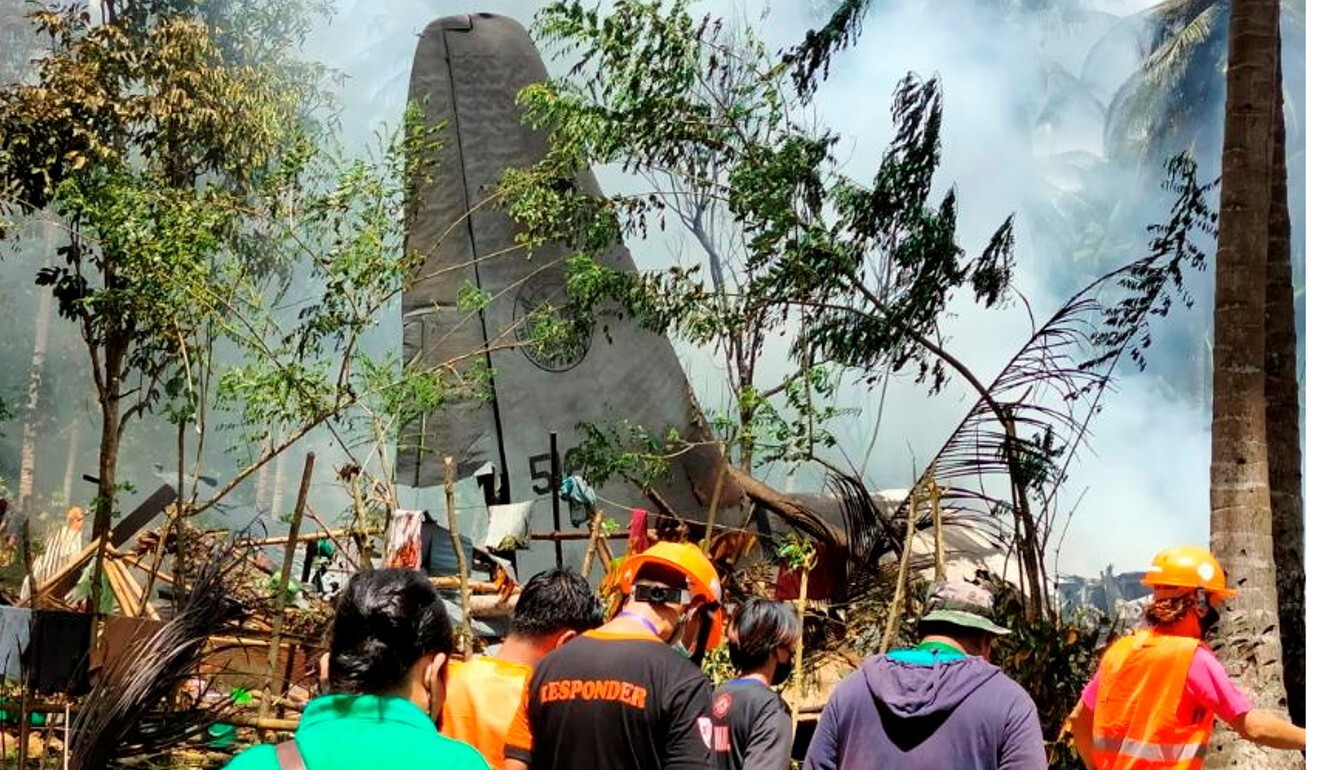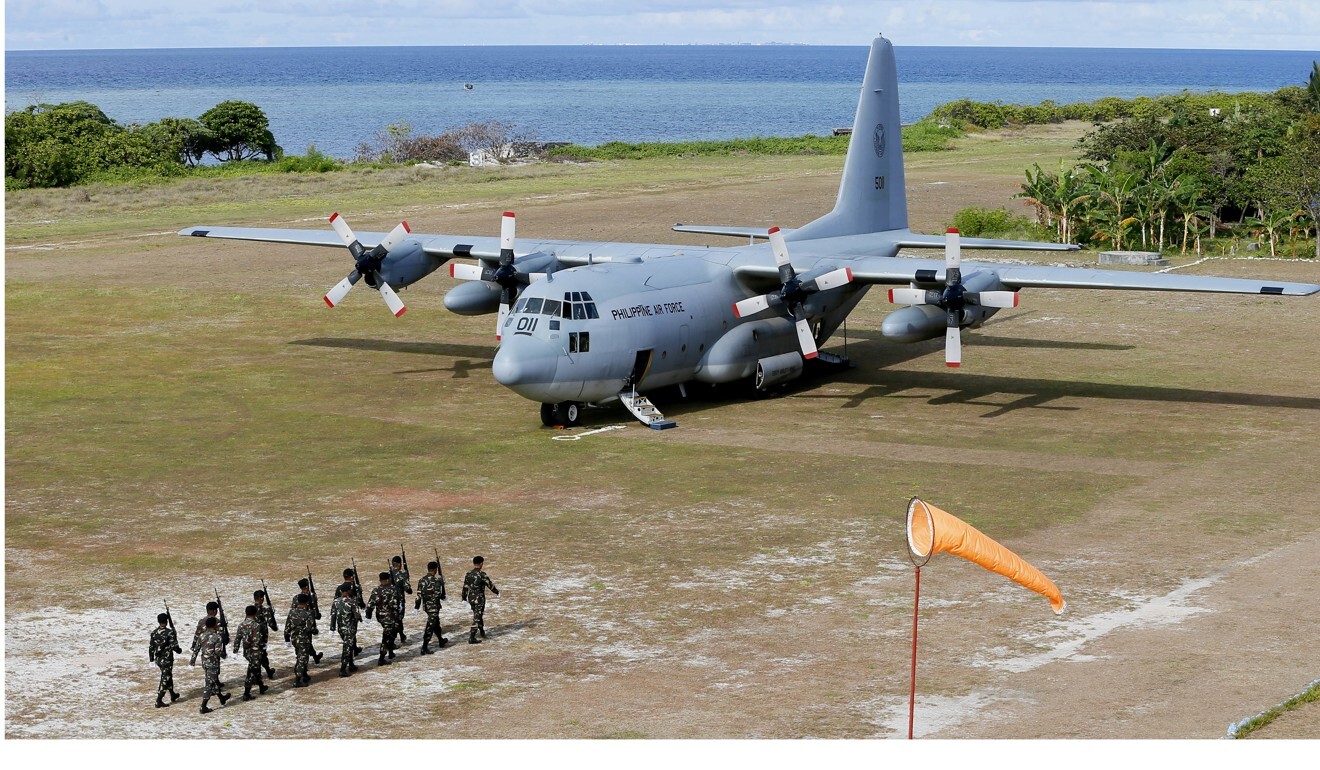
Philippine military plane crash kills 47 and injures 49 – some jumping out before impact
- The Lockheed C-130 Hercules transport aircraft was trying to land on Jolo island in Sulu province when the incident happened
- The aircraft had 96 people on board, including three pilots and five crew while the rest were army personnel. Three civilians on the ground were killed
All 96 passengers have been accounted for, military chief Cirilito Sobejana said on Monday.
At least 49 other soldiers were rescued with injuries and survived the fiery noontime crash into a coconut grove outside the Jolo airport in Sulu province, including some who managed to jump off the aircraft before it exploded and was gutted by fire, military officials said. Three of seven villagers who were hit on the ground died.
The aircraft had 96 people on board, including three pilots and five crew while the rest were army personnel, the military said, adding only five soldiers remained unaccounted for late on Sunday. The pilots survived but were seriously injured, officials said.

01:21
Military plane crash kills 47, injures 49 others in the southern Philippines
The Lockheed C-130 Hercules was one of two ex-US Air Force aircraft handed over to the Philippines as part of military assistance this year.
Officials said the injured personnel were brought to a hospital in Sulu or flown to nearby Zamboanga city and troops were continuing to search for the missing. “A number of soldiers were seen jumping out of the aircraft before it hit the ground, sparing them from the explosion caused by the crash,” a military statement said, citing witnesses.
Initial pictures released by the military showed the tail section of the cargo plane relatively intact. The other parts of the plane were burned or scattered in pieces in a clearing surrounded by coconut trees. Soldiers and other rescuers with stretchers were seen dashing to and from the smoke-shrouded crash site, where a dark grey smoke billowed soon after impact.
The plane was transporting troops, many of them new soldiers who had just undergone basic training, from the southern Cagayan de Oro city for deployment in Sulu, officials said.

“They were supposed to join us in our fight against terrorism,” Sulu military commander Major General William Gonzales said. Government forces have been battling Abu Sayyaf militants in the predominantly Muslim province of Sulu for decades.
It was not immediately clear what caused the crash. Regional military commander Lieutenant General Corleto Vinluan said it was unlikely that the aircraft took hostile fire, and cited witnesses as saying that it appeared to have overshot the runway then crashed on the periphery of the airport.
“It’s very unfortunate,” military chief of staff Gen. Cirilito Sobejana told reporters. “The plane missed the runway and it was trying to regain power but failed and crashed.”
An air force official told Associated Press that the Jolo runway is shorter than most others in the country, making it more difficult for pilots to adjust if an aircraft misses the landing spot. The official, who has flown military aircraft to and from Jolo several times, spoke on condition of anonymity because of a lack of authority to speak publicly.
Initial pictures showed that the weather was apparently fine in Sulu although other parts of the Philippines were experiencing rains due to an approaching tropical depression. The airport in Sulu’s main town of Jolo is located a few kilometres from a mountainous area where troops have battled Abu Sayyaf militants. Some militants have aligned themselves with Islamic State group.
The US and the Philippines have separately blacklisted Abu Sayyaf as a terrorist organisation for bombings, ransom kidnappings and beheadings. It has been considerably weakened by years of government offensives but remains a threat.
Philippines’ secret weapon in its South China Sea tussle: the female voice
President Rodrigo Duterte expanded the military presence in Sulu into a full division in late 2018, deploying hundreds of additional troops, air force aircraft and other combat equipment after vowing to wipe out the Abu Sayyaf and allied foreign and local gunmen.
Government forces at the time were running after Muslim armed groups a year after quelling the five-month siege of southern Marawi city by hundreds of militants linked to Islamic State group. More than 1,000 people, mostly militants and long-elusive Abu Sayyaf commanders, were killed in months of intense air and ground assaults.

Sunday’s crash comes as the limited number of military aircraft has been further strained, as the air force helped transport medical supplies, vaccines and protective equipment to far-flung island provinces amid spikes in Covid-19 infections.
The Philippine government has struggled for years to modernise its military, one of Asia’s least equipped, as it dealt with decades-long Muslim and communist insurgencies and territorial rifts with China and other claimant countries in the South China Sea.

